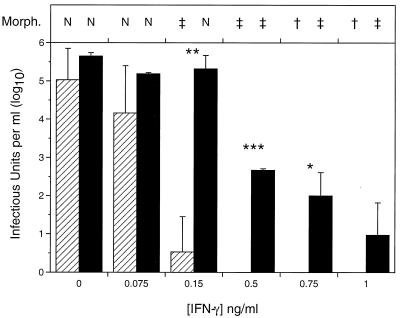FIG. 1.
Recovery of infectious chlamydiae from nonpolarized (▨) and polarized (▪) Me180 cells after IFN-γ treatment. Cells were infected, treated with IFN-γ, and harvested for infectivity at 48 h postinfection. The data are representative of several experiments and denote the means ± standard deviations for triplicate wells. Asterisks indicate statistically significant differences between polarized and nonpolarized cells by a two-tailed Welch’s t test: ∗, P < 0.05; ∗∗, P = 0.01; ∗∗∗, P < 0.0001. Compared to that in untreated samples, the infectivity decreased significantly after treatment with 0.15 ng of IFN-γ/ml in nonpolarized cells (P < 0.005 by two-tailed Student’s t test) and with 0.5 ng of IFN-γ/ml in polarized cells (P < 0.0001). Symbols above the graph indicate the morphology of the chlamydiae as follows: N, normal; ‡, many aberrant (persistent) forms; and †, scarce aberrant (persistent) forms.

